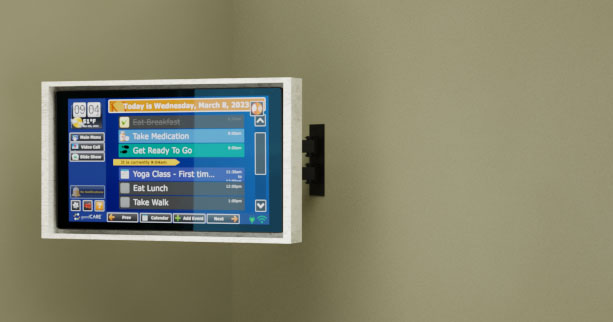A great piece from The Acorn News, written by Steve Holt
Adults with elderly parents who are frail can help them continue living at home, even if their mental or physical health is deteriorating.
It’s important for baby boomers to know about things like this. We may have a mom or a dad who is aging quickly, or we’re starting to think about our own vulnerabilities.
Also, there’s a chance we’ve visited an assisted-care facility. Even the nicer ones make us feel uncomfortable.
Too often we think of them as places where people go to die. Most of us would love to keep our parents in their own homes for as long as possible.
A new system, available at Evolution Independent Living in Agoura Hills, enables parents and caregivers to communicate with and monitor the health and activities of their older family members.
When a parent with declining health cannot care for themselves completely and an adult relative cannot help them full-time, we generally must choose from two options: 1. Place them in an assisted-living facility. 2. Hire full- or part-time caregivers.
Evolution Independent Living offers a third choice.
Jim Alexander, CEO of Evolution Independent Living, told me that a nursing home can cost between $6,000 and $20,000 per month, depending on the environment, amenities and services. Professional caregivers are also expensive, and the cost varies depending on their expertise and the number of hours they work.

HIGH-TECH—Above, Leon Frank with Evolution Independent Living shows how the GrandCare System transmits blood pressure rates.
An Evolution Independent Living
System ranges from $3,000 to $6,000, which includes installation and programming.
The final cost is determined by the system that’s needed and the size of the person’s home. Systems can also be leased for $150 to $400 per month for two to four years.
Alexander describes Evolution Independent Living as the “Grand- Care” system. It allows aging seniors to stay in their own home, instead of being forced to move into a new environment.
The centerpiece of the system is a 15-inch touch panel. It’s easily operated and is more user-friendly than a computer or a smartphone. The senior simply touches the screen to select topics such as email, news or entertainment. T h e touch panel can be equipped with a built in camera to accommodate two way Skype capability, so parents or caretakers can communicate via video.
Family members and caregivers can use computers, iPads or smartphones to access the system.
Children and grandchildren can send videos and digital images.
Small sensors keep track of all activity inside the home. If it’s Mom you’re looking after, you can tell when she went to bed, got up, her medicine or visited the bathroom.
If she has high blood pressure, the system can record it, and a graph will show her blood pressure for several months. The same information is available to a parent or caregiver on their remote device.
Mom wears a pendant around her neck. If she falls, she presses a button that sends an audible alarm through the system to designated caregivers or loved ones who are immediately alerted.
The alarm and message also appear on smartphones and computers.
If Mom is incontinent, a sensor in her bed can signal that she’s had “an accident,” so a caregiver can respond immediately.
A sensor at the door will tell when Mom leaves home and returns.
If Mom gets dementia or Alzheimer’s disease, she’ll need assisted living or full-time caregivers, but if her quality of life can be extended by staying at home for as long as possible, it’s worth considering.

Jim Alexander, CEO of Evolution Independent Living, demonstrates the brain exercise feature. RICHARD GILLARD/Acorn Newspapers
The Evolution Independent Living System is on display in a simulated apartment. Call (818) 879-0240 to see it at Evolution Audio & Video, 5341 Derry Ave., Suite S, in Agoura Hills, east of Kanan Road, off Canwood Street, in the northwest corner of the complex.
Steve Holt, former Acorn editor who retired last September, can reached at stevencholt@gmail.com.
See the article here at The Acorn.com
00







